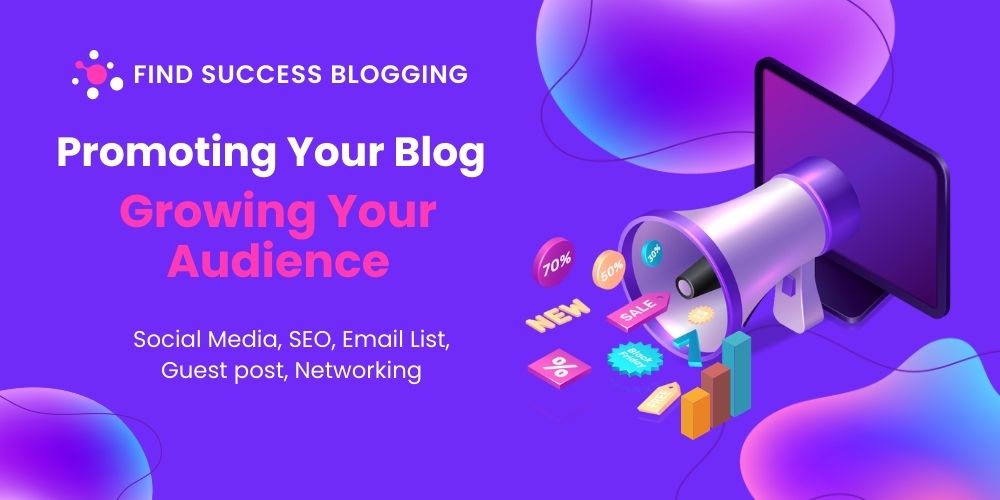
Do you want to learn how to start a blog and share your passion, knowledge, or experience with the world?
Or do you desire to make money online, build your brand, or grow your business with blogging? If you answered yes to any of these questions, then you are in the right place.
In this post, I will show you how to start a blog from scratch and the steps involved. You will learn how to choose a niche, find a platform, set up a domain name, design a logo, create content, promote your blog, monetize your blog, and more.
| At the end of this post, you will learn everything you need to start a successful blog and find success in blogging. Whether you are a beginner or an expert, this guide will help you create a blog that stands out from your competitors. This post may contain affiliate links, meaning links, I may earn a commission at no additional cost to you. |
How to Start a Blog for Beginners
Below are the steps you need to start a blog as a beginner. Let’s get started.
Choosing a Niche for Your Blog

The first step to learning how to start a blog is choosing a niche. A niche is a specific topic or area of interest you will focus on with your blog. For example, some popular ones include health, travel, fashion, food, personal finance, etc.
Choosing a niche for your blog is crucial because it will help you to:
- Define your target audience and their needs
- Create relevant and valuable content for your audience
- Stand out from the competition and attract loyal readers
- Monetize your blog more effectively and earn more income
How to choose a niche as you learn how to start a blog
- Pick a niche that you are passionate about or interested in. This crucial step will make blogging more enjoyable and easier for you. Also, you will write with more authority and authenticity because you understand the topic better.
- Next, pick a niche that has enough demand and traffic potential. This means enough people are interested in your niche and willing to read your content. You can use tools such as Google Trends, Keyword Planner, or BuzzSumo to research the popularity and trends of your niche.
- In addition, pick a niche that is not too broad or too narrow. If your niche is too wide, there will be much competition, making it hard to outrank your competitors.
Also, a narrow niche has a small audience, making it hard to grow your blog. Therefore, aim for a niche that is specific enough but also has room for expansion.
After choosing your blog niche, define your unique selling proposition (USP). A USP differentiates your blog from others in your niche and attracts even more people to read it.
Later, as you learn how to start a blog, answer the question: What value do I offer to my audience that no one else does?
Click here to learn more ways how to start a blog and make money online
Finding the Right Blogging Platform

The next step in learning how to start a blog is to find the right blogging platform. A blogging platform is a software or service that allows you to create and manage your blog online.
There are many blogging platforms available online. However, they are not all created equal. Some of the most popular blogging platforms are:
1. WordPress.org
WordPress is the most powerful and commonly used website platform in the world. It is open-source software you can install and customize on your web server.
Also, it gives you complete control over your blog with thousands of themes and plugins to enhance your blog’s functionality and appearance. WordPress.org is free, but you must pay for hosting and domain name before installing it.
I recommend Namecheap because it has affordable plans for beginners with no costly renewable fees.
Check this article to learn about other hosting plans.
2. WordPress.com
This platform is a free hosted version of WordPress.org. It allows you to create a blog without technical skills or hassle. It covers hosting, security, updates, backups, and valuable features for your blog.
However, it has some limitations, such as limited customization options, ads on your site, no plugins, etc. WordPress.com has a free plan but also offers paid plans with more features.
I recommend you use WordPress.org if you want a professional blog with unlimited customization.
3. Blogger
A popular blogging platform owned by Google is the Blogger. It is easy to use with other Google products such as Gmail, Google Drive, Google Photos, etc.
Also, it offers free hosting and domain name. However, it has some drawbacks, such as limited design options, fewer features, less support, etc.
4. Medium
This blogging platform focuses on content and community. It allows you to create a blog and publish your stories on a sleek and minimalist platform. Also, it exposes your content to a large and engaged audience involving readers and writers.
One advantage is it can drive traffic to your blog without facing Google penalties, primarily if you use similar content from your website.
However, it has disadvantages such as limited customization options, no monetization options, no content ownership, etc.
5. Wix
This platform is a website builder allowing easy blog design and creation. It features a drag-and-drop interface that lets you design your blog with ease.
Also, it offers hundreds of templates, apps, and features to enhance your blog output. However, it has drawbacks, such as expensive plans, slow loading speed, poor SEO performance, etc.
Many other blogging platforms exist, but these are some of the most popular and widely used ones. Therefore, you can compare them and choose the one that suits your needs and preferences.
However, if you want to learn how to start a blog that looks professional, flexible, and profitable, I recommend WordPress.org. So, in this post, I will focus specifically on WordPress.org as you learn how to start a blog.
| Besides, this is the blogging platform I’ve used to develop this website, and most successful bloggers also use it. After all, it gives you the freedom and power to create any blog, including monetization strategies. Also, its functionalities and features are limitless, with new ones emerging almost daily. |
Setting Up a Domain Name and Hosting for Your Blog
As you learn how to start a blog, the next step is setting up a domain name and hosting. A domain name refers to your blog’s internet address. For example, the domain name for this blog is https://findsuccessblogging.com
In addition, a hosting service is a platform that stores your blog’s files and data online. For example, I use Namecheap to host this website because it’s affordable. Also, it has a less renewable cost, unlike other hosting providers that charge cheaply for beginners and then renew with hefty charges.
Click here and start a blog today with Namecheap at affordable rates.
Steps required to set up a domain name and hosting for your blog
- Choose a domain name for your blog. Your domain name should be related to your niche, easy to remember, short, catchy, and unique. You can use tools such as Namecheap or HostGator to check the availability and price of your domain name.
- Choose a hosting service for your blog. Your hosting service should be reliable, fast, secure, and affordable. Consider tools like SiteGround or Hostinger to compare and choose the best hosting service for your blog.
- Register your domain name and hosting service. You can register your domain name and hosting service separately or together.
- Some hosting services offer free domain name registration for the first year. Use platforms like Namecheap, SiteGround, or Hostinger to register your domain name.
- Connect your domain name and hosting service to allow online blog access. Also, you can achieve this step by changing your domain name’s nameservers to point to your hosting service.
Find the nameservers of your hosting service in your account dashboard or email confirmation. Also, change your domain name’s nameservers in your domain registrar’s account dashboard or email confirmation.
If you cannot set up the nameservers, contact your provider’s customer representative for help.
After setting up a domain name and hosting service for your blog, install WordPress and configure your blog settings. At least, most reputable hosting and domain providers have reliable 24/7 help desks to assist with technical issues.
For more queries, chat with a representative via email or live chat, or check the community forums for more support.
Installing WordPress and Configuring Your Blog Settings

The next step when learning how to start a blog is to install WordPress and configure your blog settings. WordPress is a powerful software that allows you to create and manage blog posts. After all, WordPress is easy to install and use.
Below are crucial steps to install WordPress and configure your blog settings.
- Install WordPress on your hosting service. You can install WordPress on your hosting service manually or automatically. Manual installation involves downloading files from WordPress.org and uploading them to your hosting service via FTP or cPanel. Automatic installation involves a one-click installer provided by your hosting service in your account dashboard or email confirmation. So, follow the on-screen instructions or email to complete the installation process.
- Log in to your WordPress dashboard by entering your domain name followed by /wp-admin in your browser’s address bar—for instance, www.example.com/wp-admin. Replace “example” with your domain URL. Next, enter your username and password created during the installation process.
- Configure your blog’s settings to ensure your blog works appropriately and reflects your preferences.
Also, configure your blog by selecting Settings > General Settings, > Writing Settings, > Reading Settings, > Discussion Settings, > Permalinks, etc. Some of the critical settings that you should configure include:
Site title and tagline
These are the name and slogan of your blog that appear in the browser’s tab and search results. Enter your information preference in Settings > General > Site Title and Tagline.
Site address and WordPress address
These are the URLs of your blog and WordPress installation. You can enter them in Settings > General > WordPress Address (URL) and Site Address (URL).
Timezone, date format, and time format
These settings determine how your blog displays the date and time of your posts and comments. Choose them in Settings > General > Timezone, Date, and Time Format.
Default post category and format
These settings determine how your blog categorizes and formats your posts by default. Choose them in Settings > Writing > Default Post Category and Default Post Format.
Homepage display
This setting determines what your blog displays on its homepage. Display your latest posts or a static page in Settings > Reading > Your homepage displays.
Comment settings
These settings determine how your blog handles comments from your readers. You can enable or disable comments, moderate comments, require registration, etc., in Settings > Discussion > Default post settings, Other comment settings, etc.
Permalink structure
This setting determines how your blog creates URLs for your posts and pages. You can choose a simple, descriptive, or custom structure in Settings > Permalinks > Common Settings. I prefer the post name option since it makes my links look neat.
After installing WordPress and configuring crucial settings, the next step is to design your logo and choose a theme.
Designing a Logo and Choosing a Theme for Your Blog
The next step when learning how to start a blog is to create a logo and choose a theme. A logo is a graphic symbol that represents your blog’s identity and brand. In addition, a theme is a collection of files that determine the appearance of your blog.
If you choose WordPress.org for your blog, you have many customizable themes for your new blog.
Below are the crucial steps to design a logo and choose a theme for your blog.
Design a logo for your blog.
Your logo should be simple, memorable, relevant, and scalable. Use professional tools like Canva or LogoMaker to create a blog logo.
Choose a theme for your blog.
Your theme should be responsive, fast, SEO-friendly, customizable, and compatible with WordPress plugins. Websites like ThemeForest or Elegant Themes are reliable for buying premium themes for your blog.
Also, remember to use the WordPress.org platform to find and install free blog themes.
Upload your logo and theme to your blog.
You must upload your logo and theme files to your WordPress dashboard to apply them to your blog.
Most basic themes allow you to upload your logo file by choosing Appearance> Customize > Site Identity > Logo.
Also, you can upload your theme file from Appearance> Themes > Add New > Upload Theme.
After designing a logo and choosing a theme for your blog, the next step is to publish your first blog post.
Writing and Publishing Your First Blog Post

The next step as you learn how to start a blog is to write and publish your first post. A blog post is a content you create and share with your audience. It is an article related to your niche, such as a tutorial, a review, a story, a list, etc.
Click here for additional tips on how to start a blog and find success blogging.
Below are the essential steps to write and publish your first blog post:
Choose a topic for your blog post.
Your topic should discuss your niche, be attractive to your audience, and be unique to your blog. Use tools such as Google Trends, Keyword Planner, or BuzzSumo to research popular trends about your topic.
Choose a blog post title.
Choose a catchy, clear, concise, and descriptive title. Also, include the primary keyword that you want to rank for in search engines. Consider tools such as CoSchedule Headline Analyzer or Portent Title Maker to generate and optimize your title.
Write a blog post outline.
An outline is a plan that helps you organize the ideas and structure of your blog post. An outline should include the main points, sub-points, and supporting details you want to cover in your blog post.
Create and edit your outline using tools like WorkFlowy or Evernote.
Write your blog post content.
The content is the central part of your blog post that delivers your message and value to your readers. The content should be informative, engaging, and actionable.
As a result, consider using appealing headings, subheadings, paragraphs, bullet points, images, videos, etc., to make your content easy to read and understand. Also, use tools such as Hemingway Editor, ProWritingAid, or Grammarly to check and improve your writing.
Add a call to action to your blog post.
A call to action or CTA is a statement that encourages your audience to take a specific action after reading your blog post.
A CTA can request your audience to leave a comment, share your blog post, subscribe to your newsletter, buy your product, etc. Consider tools like Fluent CRM or Constant Contact to create and display attractive call-to-action buttons or forms on your blog post.
Publish your blog post.
Publish posts by clicking the “Publish” button in the WordPress editor. Also, schedule your blog posts and publish them later by clicking the “Schedule” button on the WordPress editor.
After publishing your first blog post, you have successfully started a blog! Congratulations!
Promoting Your Blog and Growing Your Audience

The next step as you learn how to start a blog is promoting and growing your audience. Promoting your blog means spreading the word about your blog to attract more visitors and followers.
Growing your audience means increasing the number of people who read, like, comment, share, and trust your blog.
To promote your blog and grow your audience, below are the essential steps:
Optimize your blog for SEO.
SEO stands for search engine optimization, which refers to improving your blog’s visibility and ranking in search engines such as Google or Bing.
The process involves using keywords, titles, descriptions, links, images, etc., to match your target audience’s search intent and queries. Installing plugins such as Yoast SEO or Rank Math helps to optimize your blog for SEO.
Share your blog on social media.
Social media platforms allow you to connect and interact with millions of people online. Popular social networks for blogs include Facebook, Twitter, Instagram, Pinterest, and LinkedIn.
Sharing your blog on social media means posting links, images, videos, stories, etc., that showcase your blog and encourage people to visit and follow it. Use tools like Buffer or Hootsuite to schedule and manage social media posts.
Click here for a comprehensive guide on how to promote your blog and get more readers.
Build an email list for your blog.
An email list is a collection of email addresses of readers who have subscribed to receive updates and offers from your blog.
An email list is one of the most effective ways to communicate and build a relationship with your audience.
Imagine readers who visit your specific post to learn about a particular topic. Once the readers get valuable info, they might never return to your blog for more information. So, the best way to keep them is to use an email list to update them with new content after publication.
After all, an email list using effective marketing strategies is one of the best methods to turn subscribers into loyal clients. This strategy works as you learn how to monetize your blog, which we will discuss later.
Besides, building an email list for your blog means creating and offering a freebie or incentive that entices people to sign up for your newsletter. You can use tools such as Active Campaign or Constant Contact to create and send emails to your subscribers.
Offer guest post services on other blogs.
Guest posting is a strategy that involves writing and publishing a blog post on another blog similar to your niche and audience.
In addition, guest posting allows you to showcase your expertise, reach a new and larger audience, and generate traffic and backlinks to your blog.
Also, it means finding and pitching relevant and reputable online blogs that accept guest posts. It also means writing and submitting a high-quality and original blog post while following their guidelines and including a bio and link to your blog.
Consider valuable tools like Ahrefs or Semrush to find and analyze potential guest posting opportunities.
Network with other bloggers and influencers.
Networking involves building relationships with people who share your interests, goals, or values.
Also, networking involves connecting and engaging with bloggers or influencers online or offline. In addition, it means offering value and support, asking for feedback and advice, collaborating on projects, etc.
Networking with other bloggers and influencers can help you gain exposure, credibility, referrals, and opportunities for your blog. Use tools like Twitter or LinkedIn to find and follow other bloggers and influencers in your niche.
| These are some of the best ways to promote your blog and grow your audience. Other methods include creating a podcast, hosting a webinar, running a contest, etc., depending on your niche, budget, and goals. |
Optimizing Your Blog for Search Engines

While learning how to start a blog, optimizing your blog for search engines is crucial. It means making your blog more visible and relevant to the people looking for information about your niche.
Search engines like Google or Bing use algorithms to rank and display the best results for each search query. Optimizing your blog for search engines involves using the following techniques.
Keyword research
This process involves finding and analyzing the words and phrases that your target audience uses to search for information online.
Keyword research helps you understand your niche’s search intent, demand, and competition. Consider professional tools like Google Keyword Planner or Ubersuggest to find and evaluate keywords for your blog.
On-page SEO
This process involves optimizing your blog page elements that affect their ranking and performance in search engines.
On-page SEO includes using keywords, titles, descriptions, headings, content, images, links, etc., that match your audience’s search intent and queries.
Consider tools like Yoast SEO or Rank Math to optimize your blog pages for on-page SEO.
Off-page SEO
This process involves improving your blog’s authority and reputation in the eyes of search engines and users.
Off-page SEO includes building and earning links, social signals, reviews, mentions, etc., from other relevant and reputable websites and platforms.
Consider tools such as Semrush or Moz to analyze and improve your blog’s off-page SEO.
| By optimizing your blog for search engines, your blog’s organic traffic, conversions, and revenue will increase too. |
Monetizing Your Blog and Making Money

Earning from a blog is the ultimate goal of any new blogger. It means generating income from your blog in several ways after offering value to your audience and partners.
It isn’t easy to earn a substantive income from a new blog. First, you should get enough traffic from readers using the promotion and SEO strategies described above.
Discover more blogging tips for beginners to help them succeed online
Once you get good blog traffic, monetize your blog with the following methods.
Advertising
This method involves displaying ads on your blog relevant to your niche and audience. Consider advertising through networks such as Google Adsense, Ezoic, and Mediavine. Also, involve direct advertisers who want to reach your audience.
Later, you will earn money from advertising based on the number of impressions or clicks your ads receive.
Affiliate marketing
This method is among the most lucrative forms of income in a blog. It involves promoting products or services from other companies or individuals related to your niche and audience.
You can apply for affiliate marketing through Amazon Associates, ShareASale, Impact Radius networks, etc. Also, apply directly with merchants who offer affiliate programs. As a result, you earn money based on the number of sales or leads generated through your affiliate links.
Click here to learn the top 10 programs to monetize your blog with affiliate marketing
Sponsored posts
This method involves creating and publishing content on your blog sponsored by a brand or company that wants to showcase its products or services to your audience.
Use platforms like TapInfluence or directly with sponsors who want to work with you. As a result, you earn money from sponsored posts based on the quality and reach of your content.
Products or services
The method involves creating and selling your products or services related to your niche and audience. Products or services may be physical or digital, like books, courses, software, coaching, etc.
Consider selling your products or services through platforms such as Shopify, Teachable, or your website. Also, this method generates an income based on the number of visitors or clients you get.
| By monetizing your blog, you can create multiple income streams and achieve financial freedom. Remember, the more blog traffic, the greater your income or earning potential. |
Tracking and Analyzing Your Blog Performance
![]()
The last way to learn how to start a blog is to use tracking and performance tools.
This method involves measuring and evaluating the results of your blog activities and strategies. Below are the crucial tools to consider.
Google Analytics
This free tool helps you monitor and understand your blog visitors, user behavior, and characteristics.
Google Analytics enables you to track traffic sources, sessions, page views, bounce rate, conversion rate, metrics, etc. Use Google Analytics to optimize your blog for user experience and satisfaction.
Google Search Console
This tool helps you monitor and improve your blog’s visibility and performance in search engines.
Google Search Console tracks metrics like impressions, clicks, rankings, errors, etc. Use this tool to optimize your blog for SEO and technical issues.
Social media analytics
These tools monitor and improve your blog’s presence and engagement on social media platforms.
Also, social media analytics can track metrics, such as followers, likes, comments, and shares. So, use social media analytics to optimize your blog for social media marketing.
| When you track and analyze your blog performance, you identify and leverage your strengths and weaknesses and make data-driven decisions for its growth. |
Conclusion on How to Start a Blog
Blogging is a rewarding and fulfilling career that allows you to express yourself, share your knowledge, and help others. Also, it is a profitable and sustainable business to help you achieve your personal and professional goals.
You don’t need to be a technical expert or a professional writer to start a blog. You just need to follow the simple steps below:
- Choose a niche for your blog
- Select your blog platform
- Set up a domain name and hosting for your blog
- Install WordPress and configure your blog settings
- Design a logo and choose your blog theme
- Write and publish your first blog post
Promoting and growing your blog to your audience
- Optimizing your blog for search engines
- Sharing your blog on social media
- Building an email list
- Guest posting on other blogs
- Networking with other bloggers and influencers
Also, track and analyze your blog performance using Google Analytics, Google Search Console, and social media analytics. These free tools monitor and analyze your blog performance as you monetize it.
In summary, the above steps help you to immediately learn how to start an attractive, functional, and successful blog. In addition, you can create and deliver valuable content that resonates with your audience.
I hope this guide has helped you decide how to start a blog today. For questions or comments, please leave them below. I would love to hear from you.
Happy blogging!
| Do you know other ways to help readers learn how to start a blog that I might have missed? Kindly share them in the comment section below, or let us know your opinions about this post. Don’t forget to subscribe to our newsletter for updates on our latest posts. Also, if you enjoyed reading this post, share this message with your friends on Facebook, Twitter, and other social media sites. Let’s find success in blogging together. |


